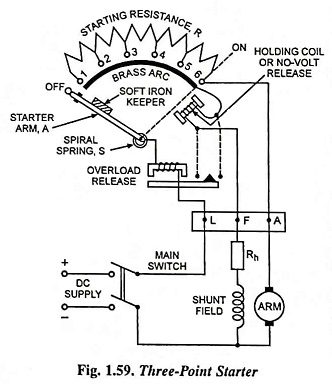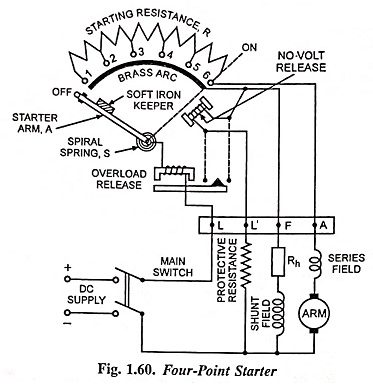3 Point Starter and 4 Point Starter -Construction and its Workings:
The starter for a shunt motor (3 point starter) is shown in Fig. 1.59. At start all resistances are in series with the armature, the holding coil (through the starter arm A) is across the line. As the speed builds up and the back emf increases the arm A is moved to the right. This decreases the armature resistance and the armature has greater emf.
At normal speed when the back emf is large enough to limit the armature current, the holding coil and starter arm A make contact. Both the field and armature are directly across the line. Current through the holding coil keeps the arm in this position. If for any reason the line voltage should fail, the magnetic field of the holding coil ceases and under the action of the spring the arm goes back to its off position. This will keep the line voltage open. Because of this action the starter protects the motor.
Restarting after a line voltage failure can only be done by using the protective series resistance in the armature circuit. The starter is also provided with a overload release coil to protect the motor against the flow of excessive current due to overload. This coil is connected in series with motor and so carries full-load current. When the motor is overloaded it draws heavy current, which also flows through the coil and magnetises it to such an extent, that it pulls its armature upwards and so short circuit the no-voltage release coil, as shown in Fig. 1.59. The no-volt release coil being short circuited demagnetises and releases the starter arm which goes back to the off position and the motor is automatically disconnected from the supply mains.
In a 3 point starter, discussed above, no-volt release coil is connected in series with the shunt field and the field rheostat, and therefore, the current flowing through the field is the same current that flows through the holding coil. Thus if sufficient resistance is cut in by the field rheostat so that the holding coil current is no longer able to create sufficient electromagnetic pull to overcome the spring tension, the starter arm pulls back to the ‘off’ position. Hence 3 point starter is unsuitable for use with speed-controlled motors and that has resulted in the wide spread application of four-point starters. A 4 point starter with its internal wiring connected to a long shunt compound motor is shown in Fig. 1.60. In this arrangement ‘no-volt release coil’ circuit is independent of shunt field circuit and, therefore, it will not be affected by the change of the current in the shunt field circuit.

